At Last: Galaxy Without Dark Matter Confirmed, Explained With New Hubble Data
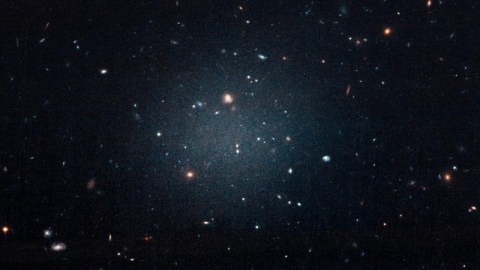
Despite all the challenges, Hubble has vindicated this discovery.
Practically everywhere we look in the Universe, the large-scale objects that we see — small galaxies, large galaxies, groups and clusters of galaxies, and even the great cosmic web — all not only contain dark matter, but require it. Only in a Universe with far more mass than normal matter can provide, and in a different form from the protons, neutrons, and electrons that scatter and interact with themselves and with light, can our observations be explained. However, an interesting consequence should arise in a Universe with dark matter: the existence of a small but significant population of galaxies containing no dark matter at all.
For many years, these galaxies went undiscovered, providing ammunition to those ideologically opposed to the existence of dark matter. But in 2018, a team of researchers led by Pieter van Dokkum and Shany Danieli claimed to have discovered the first: a diffuse satellite galaxy of the large, nearby elliptical NGC 1052. The galaxy, NGC 1052-DF2, has been the subject of much scrutiny and debate, as the properties of this galaxy could help unlock the mysteries of the Universe’s dark side. With a new set of observations from Hubble, we not only have confirmed that his galaxy indeed has no dark matter, but we can finally fully explain what’s happening. Here’s the scientific story.
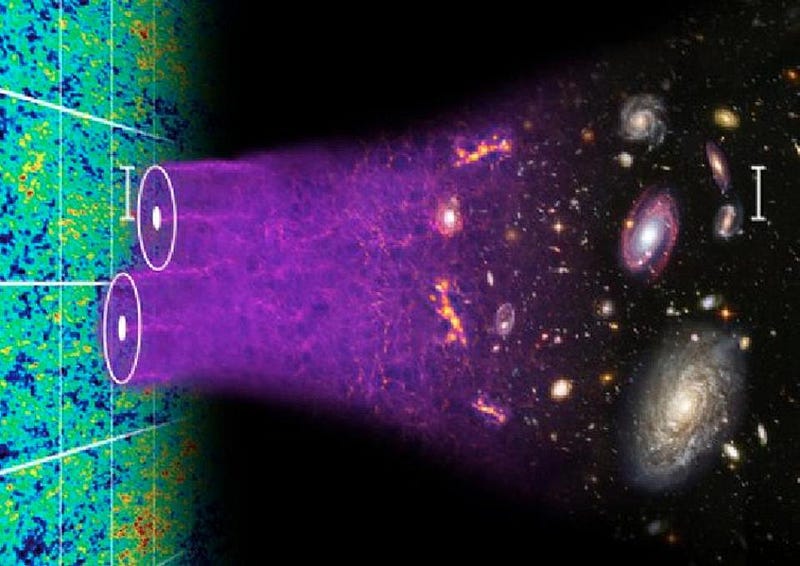
In theory, there’s about five times as much dark matter, by total mass, as there is normal matter in all its forms in the Universe. When the Universe was very young, all the forms of matter attempt to gravitationally collapse, with the overdense regions attracting more and more matter into them. Meanwhile, radiation flows out of these growing overdensities, and the increased pressures and densities push back against the normal matter differently than the dark matter. These early phases to the Universe provide our cosmos with these gravitational seeds that will later grow into stars, galaxies, and the large-scale structure of the Universe.
Overall, dark matter dominates the cosmic web, while the normal, baryonic matter collapses down to much smaller volumes, triggering star formation and giving rise to stellar systems. Gravitational interactions, collisions, mergers, and tidal forces all have the potential to separate dark matter from normal matter, while star formation tends to expel normal matter from bound structures. On average, large structures form with the same 5-to-1 ratio of dark matter to normal matter as the overall cosmos, but most smaller structures can have much of their normal matter stripped away while leaving the dark matter behind. In the most extreme cases, we can see dark matter-to-normal matter ratios of 600-to-1 or even greater.
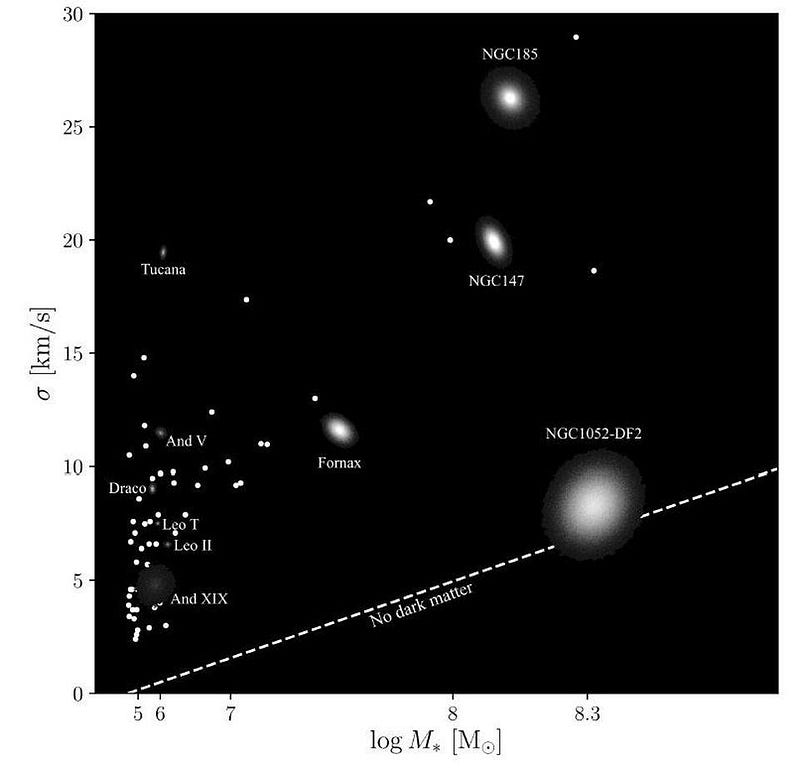
Dark matter, in many ways, functions as the “glue” that holds the luminous, stellar matter together in gravitationally bound structures. Especially where galaxies interact, where gas stripping occurs, and where significant tidal forces disrupt otherwise quiet structures, dark matter and normal matter can be separated from one another. Normal matter structures should come to exist, but only briefly. Without the gravitational influence of dark matter to hold these bound structures together, they should be gravitationally ripped apart in only a few hundred million years, with only a very, very rare structure surviving the first billion years without dark matter.
That’s why the 2018 announcement of the properties of NGC 1052-DF2, hereafter known as DF2 for short, came as such a shock. The researchers, using a novel instrument known as the Dragonfly telescope, were able to measure the velocity dispersion of the stars inside this small, distant galaxy, along with a number of other properties. What they found was fascinating:
- the stars within this galaxy, as well as the globular clusters that orbited it, were moving around at only ~8 km/s, where a normal amount of dark matter would yield a value more like ~30 km/s,
- the galaxy itself was quite distant: ~64 million light-years away,
- but from the stars inside, we can infer that it hasn’t formed stars for about ~7 billion years.
Immediately, the scientific community took up the necessary task at hand: to try and scrutinize these claims as rigorously as possible, and demand the extraordinary evidence to validate this exciting, but controversial, claim.
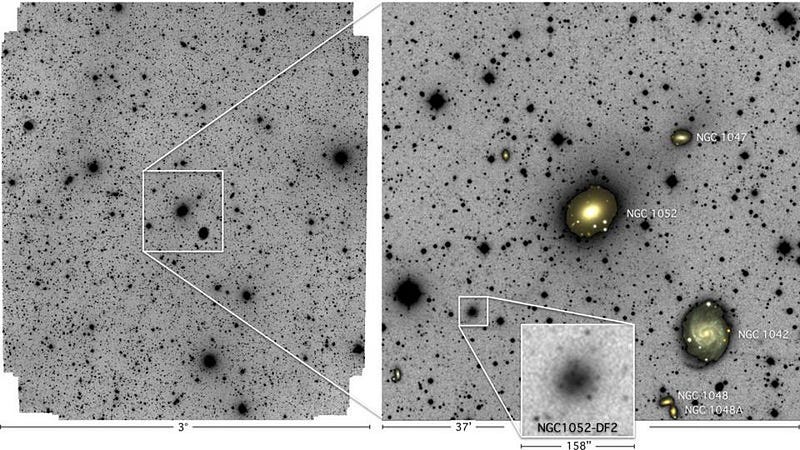
The first attempt to knock this discovery down came in the form of a challenge to the observations: were the measured velocity dispersions — which allow us to infer the speeds of the stars within and globular clusters around this galaxy — incorrect? If so, then those speeds are also incorrect, and perhaps dark matter is present, after all. Using a completely different instrument and data set, a rival collaboration measured the individual globular clusters that are bound to DF2, and based on their line-of-sight motions to us, inferred a velocity dispersion that was more than double the original value. Perhaps the observations were in error, and this cross-check with the MUSE instrument would expose it.
But it wasn’t to be. The MUSE instrument, as it turns out, did not have the necessary spectral resolution to make accurate enough measurements to actually determine the velocity dispersion of these globular clusters to the necessary accuracy. Follow up measurements with a far superior instrument — the Keck Cosmic Web Imager (KCWI) — showed that the MUSE data was, in fact, “smoothed out” because of their lower resolution, while the KCWI data showed just how peaked and narrow these spectral lines are. From both stars (~8.4 km/s) and globular clusters (~7.8 km/s), the latter of which are approximately four times more distant (and so should be more sensitive to the presence of a dark matter halo), it robustly appears that there was no trace of dark matter in this galaxy at all.
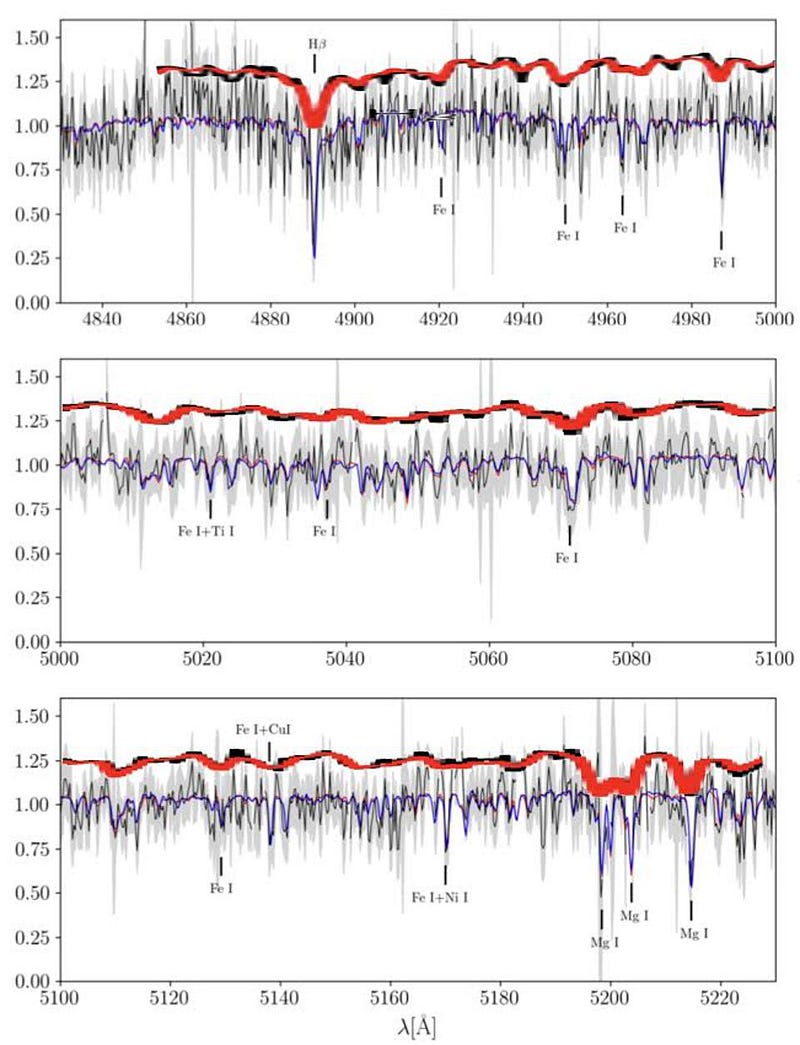
But could there be another explanation for these observations? As it turns out, there was. A galaxy that has these narrowly peaked spectral lines could be devoid of dark matter if it were at the originally inferred distance of ~64 million light-years, but could exhibit the same spectral features if it possessed dark matter but were actually closer. The only way to break this degeneracy would be to take accurate, independent measurements that would nail down the distance to this galaxy, irrespective of any assumptions made.
While the original team of Danieli and van Dokkum claimed to do precisely this, another challenge swiftly arose, this time from a team led by Ignacio Trujillo and Mireia Montes. Using a variety of independent techniques, Trujillo’s team claimed that DF2 was not actually 64 million light years away and a satellite of NGC 1052, but rather was a satellite of a closer, nearby galaxy, NGC 1042, and was located much closer: at a distance of just 42 million light-years. A second method leveraged by both teams, based on surface brightness fluctuations, again yielded different answers depending on who was doing the analysis.
If the galaxy is closer, then it’s intrinsically fainter, and there’s less mass in the form of stars. Where’s the rest of the mass? Perhaps it’s there, after all, in the form of dark matter.
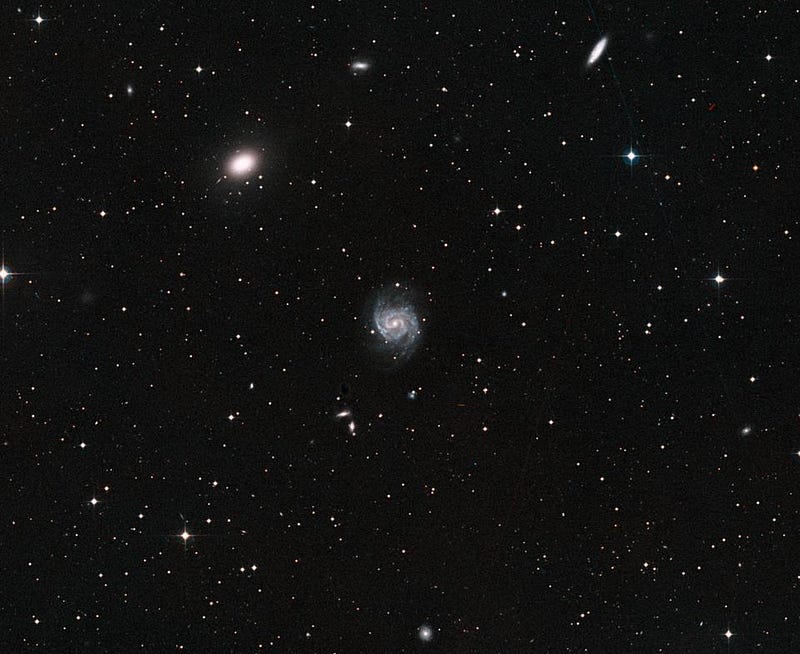
So, who was right? One team claimed to have the distance nailed down to a high value with a low velocity dispersion, indicating that there’s no dark matter inside. Another team claimed to have the distance nailed down to a lower value with the same low velocity dispersion, indicating that there is dark matter inside. Both sides in this debate pointed towards not only their own data and methods, but to circumstantial evidence that supported their position: the existence of NGC 1052-DF4 (colloquially known as DF4), which appeared to be a second galaxy at the same distance with no dark matter, versus the confusing proximity on the sky of both NGC 1035 and NGC 1042, which occupy nearly the same line-of-sight as the more distant NGC 1052.
Whenever there’s a dispute of this nature, the best solution isn’t to quibble over whose data is more reliable, but rather to take superior measurements that yield an unambiguous answer.
To pin down the distance to an object such as this, the best option is to measure distances directly with the Hubble Space Telescope. While velocity dispersions are a good measurement to make, it’s better to measure the properties of individual, evolved, luminous stars. Specifically, stars on the tip of the red giant branch allow us to determine distances very specifically, and that’s the kind of measurement that Hubble, unique among our observatories, is capable of making.
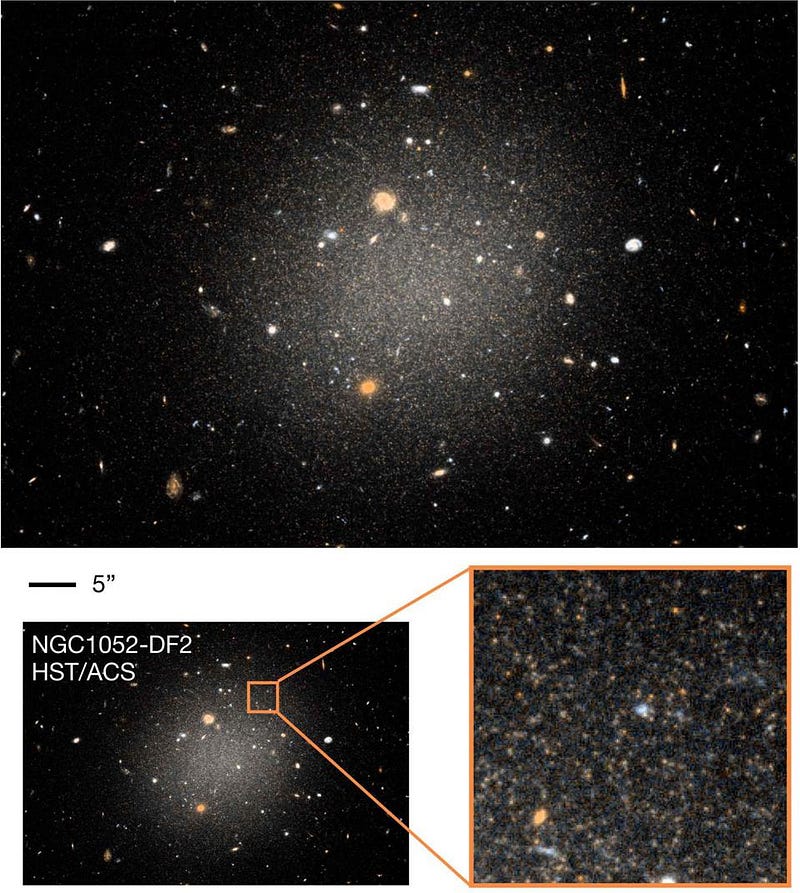
That’s what’s so exciting about the latest release from Hubble and the van Dokkum team, which now includes Zili Shen along with van Dokkum and Danieli. The ultra-diffuse galaxy known as DF2 was measured to have a distance, using this tip of the red giant branch analysis with a whopping 40 Hubble orbits, pinned down the distance at a surprisingly high value of 72 million light-years, with an uncertainty of just ±4 million light-years on that value. This precise measurement should settle at least one of the issues surrounding this galaxy: it really is quite distant, implying that there is very little dark matter, and possibly even no dark matter, present to hold this galaxy together. According to Pieter van Dokkum,
“We went out on a limb with our initial Hubble observations of this galaxy in 2018. I think people were right to question it because it’s such an unusual result. It would be nice if there were a simple explanation, like a wrong distance. But I think it’s more fun and more interesting if it actually is a weird galaxy.”
This aligns with prior Hubble observations of DF4, which used the tip of the red giant branch to determine a distance of 65 million light-years (±5 million light-years) for that galaxy. Now that the distance to both galaxies has firmly been established, along with the measurements of the internal motions of the stars and globular clusters within this galaxy, the ultimate challenge remains: explaining why and how this galaxy exists at all.
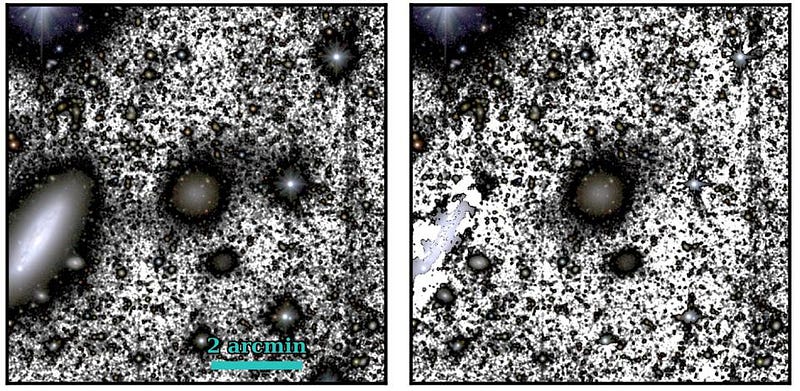
Perhaps surprisingly, a compelling explanation becomes apparent if we fold in one other piece of data obtained by Mireia Montes from Trujillo’s rival team: the discovery that DF4 is presently undergoing tidal disruption. If these small, diffuse galaxies are relatively close to one (or more) other massive galaxies, then galaxies like DF2 and DF4 can be sheared apart from the outside-in.
First, the outskirts of the galaxy will be gravitationally disrupted, ejecting the most tenuously held components of the galactic halo: the outer, dark matter-dominated regions. As the galaxy loses mass, it evolves to become more diffuse, as the stars move more slowly and in less tightly-bound orbits.
The fact that a small tidal stream is seen in the stars of DF4 could be a hint that these galaxies are only free of dark matter right now; a short while ago, they had much more dark matter, while some time from now they’ll be torn apart completely. They exist as they do, today, because we’re only seeing them at a snapshot in time, and we can only see the luminous matter at that. Even though the latest observations show no evidence for the tidal disruption of DF2 or DF4, this explanation cannot be ruled out.
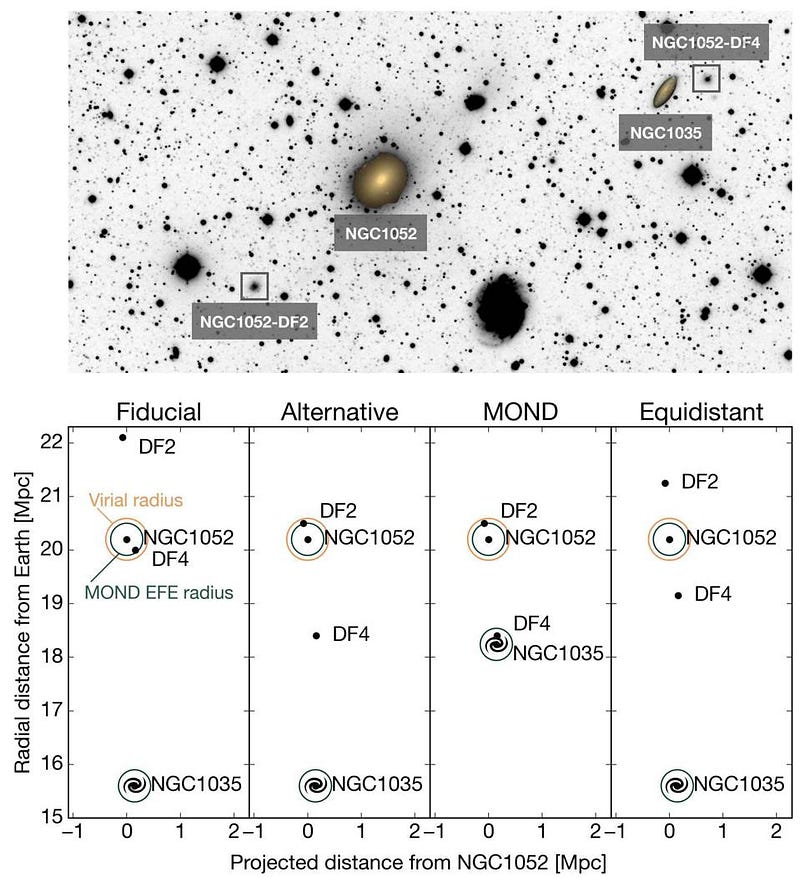
It should be impossible for a galaxy that has no dark matter to persist in an environment like this for ~7 billion years, but the existence of not just one but two ultra-diffuse dwarf galaxies that don’t appear to possess dark matter is certainly “interesting,” as van Dokkum said. Either these galaxies had copious amounts of dark matter and have lost/are in the process of losing it, they’re in a transient rather than a stable state, or — perhaps most curiously — there’s something else going on.
That “something else” includes the idea that there’s no dark matter, and that the rules of gravity must be modified instead. The idea of an external field effect suggest that these ultra-diffuse galaxies could possess their observed properties if they’re being influenced by a close, much larger, much more massive galaxy.
It’s very well-measured that DF2 and DF4 are separated by about ~7 million light-years, so while one of them could be very close to NGC 1052, both of them simultaneously cannot. However, there is a large-enough nearby galaxy, NGC 1035, that could be close to DF4 if NGC 1052 is close to DF2. A precise measurement of NGC 1035’s distance could either offer support for the external field effect from modified gravity, or, alternatively, could demonstrate the insufficiency of modified gravity and the necessity of dark matter. As always, only time, and future observations, will tell.
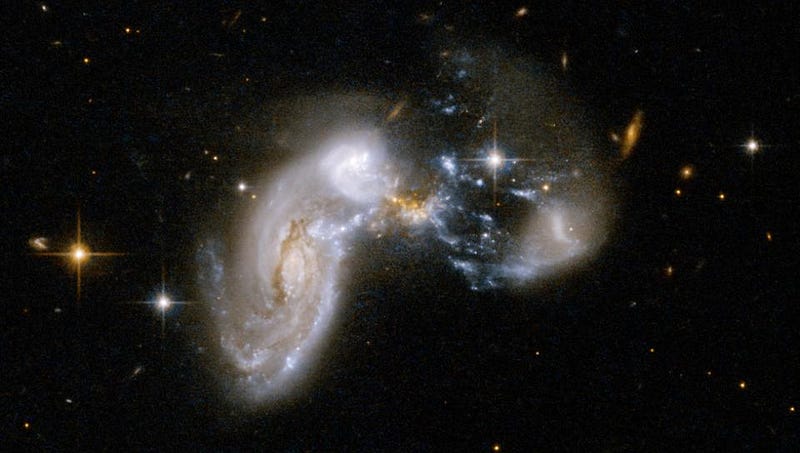
Based on the best data we have, however, we can reach a number of incredible conclusions. First, there are two ultra-diffuse galaxies that appear to be satellite members of a massive group dominated by NGC 1052: DF2 and DF4. They’re 72 and 65 million light-years away, respectively, as precisely determined by Hubble observations. They have very strong and narrow spectral features, indicating the slow motions of their internal contents: consistent with having no dark matter at all. These galaxies have formed no new stars over approximately the latter 50% of the Universe, and may be in the process of being torn apart by tidal interactions.
However, many questions still remain surrounding them. Are they in close proximity to large, massive galaxies, or are they between them? Are they in the process of being tidally disrupted, or have they been in this configuration for some time? If we return in a few hundred million years, will these galaxies still persist, or will galactic interactions destroy them? With the discovery of two galaxies that truly appear to be devoid of dark matter, we’ve cracked the window open to the next steps in our astronomical understanding of the Universe. As the next generation of telescopes opens a new set of eyes on the Universe, perhaps it will be the galaxies that lack dark matter that finally point towards a solution to this longstanding cosmic conundrum.
Starts With A Bang is written by Ethan Siegel, Ph.D., author of Beyond The Galaxy, and Treknology: The Science of Star Trek from Tricorders to Warp Drive.





